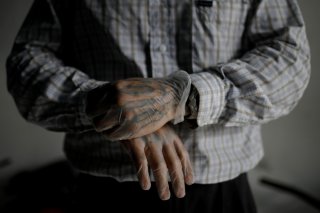How Gangs and Drug Dealers Adapted to the Pandemic Reality
Demand for drugs did not disappear in lockdown.
As lockdown loomed, most people rushed to buy toilet paper and paracetamol, openly voicing fears of falling ill. But “ill” for addicted drug users has a different meaning. It means to suffer withdrawal symptoms due to missing a regular hit of either heroin or crack cocaine.
While some party people will have stockpiled or bulk bought their lockdown supply of recreational drugs, most heroin and crack cocaine users will have lacked the financial means to do this. My recent book on drug distribution and exploitation in London and the southeast of England, County Lines, revealed how purchasing these drugs is a haphazard, often communal endeavour with daily routines and frustrations.
But demand, at least, is a constant. The gangs that supply these users have had to cope with various new complications to dealing as a result of lockdown, and have had to adjust their business models accordingly. Gang members also remain active online, with rivalries likely to spill out onto the street as lockdown measures ease.
Lockdowns across Europe exposed the international supply routes so favoured by organised-crime groups in their effortless ability to bring drugs into the UK. Trains and boats and planes were suddenly absent, leaving bulk-product transportation more easily visible to both the National Crime Agency and customs officials, who quickly benefited with successful seizures and prosecutions.
Unsurprisingly the street price of drugs escalated sharply. For those local street boys already sitting on a modest supply of previously purchased product, inflated prices could now be charged and profits doubled or tripled.
Highly adaptive business models
Street gangs and county lines crews who deal in illegal Class A drugs are among the most adaptive criminals of the moment. I interviewed dozens of them for my recent book and so it’s been easy to see how they could circumvent the problem of lockdown and still get their supplies to the market.
Years of coping with postcode wars, rival territorial incursions, invasive policing operations onto their estates, staff absences due to stop and search, arrest or homicide has paid dividends of insight and invention to create highly adaptive business models. Always quick to read the runes and never shy to make the necessary changes – however brutal – they simply adapt supply and distribution methods to ensure the product gets to market.
My sources tell me that the supply of drugs from metropolitan centres to provincial or seaside towns now involves medium bulk deliveries in cars rather than sending boys down on empty trains and buses, where they would be more likely to be spotted by authorities. Dealing can now take place from cars in local supermarket car parks and even hospital car parks, with the money and drugs tossed between dealer and user.
To address potentially increased visibility arising from reduced pedestrian footfall, dealers have sought to legitimise their reason for being outdoors. Thus they dressed as joggers to blend in or created fake NHS IDs and lanyards and posed as key workers or carers. Some reports even talk of NHS workers mugged for their ID. With face masks now commonplace among ordinary citizens, dealers can also legitimately hide their faces from CCTV.
The practice of cuckooing – using the home of a vulnerable user or person to deal drugs – has declined. Dealers are fearful of the involvement of the authorities lest the vulnerable person falls ill. Thus dealing from locally established hubs is now more common.
While some dealers stay locked down at home, other young dealers have actively taken up the role – through force in some situations. Some seek relief from lockdown boredom, while others find falling family incomes an imperative for action to make money. Users, however, now find familiar faces have moved on, meaning trust must be re-established with a new dealer. Transactions are more hurried and the risks are heightened.
New online threats
Behind the scenes, bored youth are more active than ever on social media. Here street gangs have an open playing field for grooming and recruitment that is free from adult governance or intervention. Unsuspecting young people can be pulled into the orbit of the gang without realising it. An unguarded comment or opinion on a rap or drill video can bring the promise of retaliation and months spent in fear of a sudden revenge attack for having disrespected a gang affiliate.
Zoom bombing and gatecrashing online House Party sessions is a whole new arena where disrespect can also be paid (intentionally or inadvertently) to wider groups of young people. Rivalries will have been bred and birthed during lockdown, just as they are on the street. But lockdown will have resulted in it being stored up – anger and the desire for revenge no doubt nursed, ready for action as soon as lockdown started to ease. Disrespect is never forgotten “on road”, as the business of drug dealing is known.
It’s not all bad news, though. Lockdown has witnessed some police success in targeting housebound gang members. And authorities have keenly reported some young people using this time to reflect upon their involvement in crime.
But lockdown has also removed access to the youth workers, school teachers, social workers and adults who might be in a position to support, guide or intervene with anxious youth, meaning this teachable moment is all but lost. If it’s not too late, we should seek to act quickly on any ground gained.
The alternative will be an unpleasant reckoning and settling of scores with violent outcomes against anyone perceived as disrespectful. These retaliatory violent acts will be posted on social media for commentary and humiliation and the whole cycle will start again.
![]()
Simon Harding, Professor of Criminology and Director of the National Centre for Gang Research, University of West London
This article is republished from The Conversation under a Creative Commons license. Read the original article.
Image: Reuters

